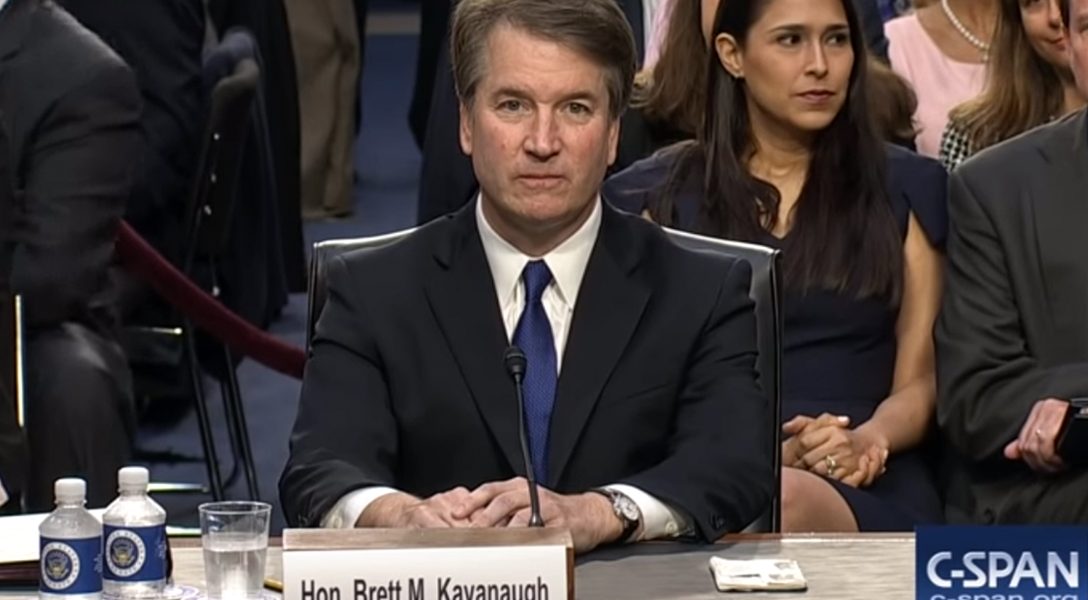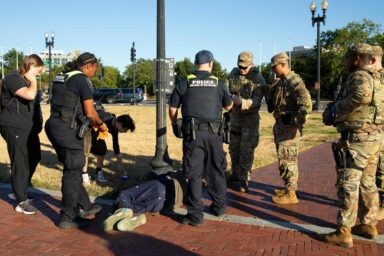Democrats tried to expose some of his more conservative views, but Supreme Court nominee Brett Kavanaugh hid behind the fine print.
The following is WhoWhatWhy’s take on these incredible and historic four days. Unlike other news outlets, we offer a comprehensive story. We did not try to do this in incremental pieces, or by referring you to videos. It captures, as best we can, some of the major issues on which Kavanaugh’s vote will make a difference. And it helps you understand Kavanaugh the man. What drives this ultra-conservative judge? How does he make his decisions? What he demonstrated during the hearings is a coldness that does not bode well for the republic.
This is a man who can advocate for female law clerks, but cannot — or will not — understand the pain of a teenaged undocumented immigrant in her fourth month of pregnancy; who says he tutors students from low-income neighborhoods, but does not understand the destructive role that guns play in their world; who can espouse Catholic social-justice teaching, but sees no disconnect in gutting regulations that protect the public’s health and safety.
In the four days senators considered Brett Kavanaugh’s qualifications to be the next Supreme Court justice, Democrats went through the five stages of grief: denial, anger, bargaining, depression, and acceptance or, rather, resignation.
Kavanaugh would replace Justice Anthony Kennedy, the court’s swing vote, a conservative who sometimes sided with his more liberal colleagues on the bench. Kavanaugh would join the court at a time when the third branch of government — the judiciary — never seemed more important. “Fears of authoritarian rule are rampant in this country,” said Sen. Richard Durbin (D-IL) because of concerns about “a president willing to walk away from rule of law.”
Yet the Democrats had little power to change history; they are in the minority. If all 51 Republicans hang together, due to a rule change that no longer requires 60 votes for confirmation, they won’t need any Democratic votes to approve President Donald Trump’s nominee to the Supreme Court. Nothing happened last week that will likely change this outcome.
Related: Justice Kennedy’s Departure a Grim Prospect for Election Reform
Denial and Anger Over a Rigged Process
.
On the first day of the hearing, there were both denial and anger as Democrats attempted to postpone the hearing through procedures that were ruled out of order by Sen. Chuck Grassley (R-IA), chair of the Senate Judiciary Committee.
The Democrats charged that the process was both rushed and rigged. They had not received tens of thousands of documents related to Kavanaugh’s 35 months as staff secretary to President George W. Bush, and the thousands of documents they did receive were marked “committee confidential,” and could not be used to question Kavanaugh in open session.
A process where documents are routinely screened by the National Archives was subverted, they contended. Since the National Archives needed more time to screen the documents — until October 31 — the review process was handed over to Bill Burck, a former Bush administration official and Kavanaugh colleague, whose clients include former Trump Chief of Staff Reince Priebus, Trump White House counsel Don McGahn, and former Trump adviser Steve Bannon.
“Who is Bill Burck?” was the battle cry of the first day. “The whole process has gone astray,” Sen. Richard Durbin (D-IL) charged.
But Senate Republicans also were angry, because of the presence of protesters who disrupted the hearing. The raucous citizens were taken out — some dragged out — by the Capitol Police. It was all too much for Sen. John Cornyn (R-TX), who complained that “mob rule” had taken over. “I don’t know if the committee should have to put up with this insolence today,” added Sen. Orrin Hatch (R-NV), who called one female protester a “loudmouth.”
Bargaining
.
The next two days, Democrats tried to find some question that would unsettle the nominee and elicit a telling response. Senate Republicans agreed to publicly disclose many more confidential documents. But the extra documents did not seem to help.
Instead, Democrats found themselves trying to gain traction with the public and the media by raising concerns about a man who seemed not venal, but nice.

On paper, they had a lot of material: The judge had a 12-year record of decisions that prompted scores of civil rights, women’s rights, consumer, gay rights, and public health advocates to publicly oppose him.
Georgetown University law professor Lisa Heinzerling charged that the judge was concerned only with the “liberty” of regulated industries, disposed to give these special interests “a freedom to harm other people with minimal government constraint.”
Last July, Washington Post business columnist Steven Pearlstein warned that Kavanaugh could overturn a key Supreme Court decision, Chevron U.S.A., Inc. v. Natural Resources Defense Council, Inc., that requires courts to defer to federal agencies’ interpretation of a law when the legislation is ambiguous or silent on certain points. Essentially, the Chevron decision gives agencies the power to develop regulations to address emerging threats or new technology, which Congress could not have foreseen.
During his 12-year tenure on the US District Court of Appeals for the District of Columbia, Pearlstine charged, “Kavanaugh has waged a crusade against the regulatory state that a cynic might think was designed to raise his profile and made him the darling of pro-business, anti-government conservatives.”
But Republicans showcased another side of the nominee: the family man, who coached a girls’ basketball team; the devout Catholic who volunteers at a soup kitchen; the advocate and mentor for women and people of color who aspire to legal careers.
.
“I understand real-world effects of our decisions,” Kavanaugh said. “I have gone out of my way in my opinions to make clear that I understand the circumstances, the facts.” He described himself as a “pro-law judge… an independent judge.” In his court, he said, “if you have the better legal arguments, you will win.”
But Kavanaugh showed a different side to Fred Guttenberg, whose daughter was gunned down last February during the mass shooting at Marjory Stoneman Douglas High School in Parkland, FL. Guttenberg, who attended the hearing, attempted to shake the judge’s hand. It didn’t go well.
Kavanaugh pointedly turned away, or so it seemed. Guttenberg tweeted about it.
Just walked up to Judge Kavanaugh as morning session ended. Put out my hand to introduce myself as Jaime Guttenberg's dad. He pulled his hand back, turned his back to me and walked away. I guess he did not want to deal with the reality of gun violence.
— Fred Guttenberg (@fred_guttenberg) September 4, 2018
Kavanaugh was also quick to turn away from probing questions.
Democrats did their best to discuss the nominee’s record and to assess how he would vote in the future. It was largely a doomed effort.
Fine Print, Less-Than-Fine Motives?
.
In nearly all his answers, Kavanaugh explained his decisions by delving into the fine print of the law. Asked to consider the real-world effects of those decisions, the judge contended that as long as he explained the legal underpinnings of his decision, he was being fair to the people who might be harmed by it.
Take for example, his dissent in a rare abortion case that came before the DC district court. Kavanaugh would have denied a 17-year-old undocumented immigrant access to an abortion, despite the fact that she was nearly 15 weeks pregnant and had complied with Texas state law, including visiting a pro-life counseling center and receiving a judge’s permission to waive the parental consent requirement. He wanted to give federal officials 11 more days to find her a sponsor to advise her before the procedure could be approved.
Sen. Richard Blumenthal (D-CT) accused Kavanaugh of ignoring the health risks that further delay would cause the immigrant, or the “emotional turmoil” she was in.
Kavanaugh defended his decision, saying he was merely going by precedent. He referred to the 1992 Supreme Court decision, Planned Parenthood v. Casey, in which the justices advised that “minors would benefit from consultation.” “I did the best I could to follow the precedent of the Supreme Court.”
But Blumenthal suspected Kavanaugh had other motives.
In 2016, he observed, Kavanaugh had not been on Trump’s list of candidates for the Supreme Court. At the end of 2017, after his ruling that October, Kavanaugh was on the list. Trump had pledged to nominate only those judges he trusted to oppose abortion.
“What had changed?” between the first and second lists, Blumenthal asked.

“A lot of judges and lawyers I know made clear to various people that I should at least be considered,” Kavanaugh responded.
Kavanaugh also repeatedly told Senators that Roe v. Wade, the 1973 decision that legalized abortion, had been reaffirmed by the court in 1992, and thus had strong judicial precedent supporting it. However, he refused to say that it had been “correctly” decided.
Kavanaugh made the same deep dive into the legal fine print to justify his vote to strike down Washington, DC’s ban on assault weapons. It all came down to earlier Supreme Court decisions that said that the second amendment permitted the regulation of “unusual and highly dangerous” weapons like machine guns, but not those “in common use,” he said. Since assault weapons were “widely used,” they didn’t fit the court’s definition of guns that could be restricted.
Kavanaugh was the dissenting vote in the DC ban decision; the two other judges on the three-judge panel wrote a detailed decision that also cited Supreme Court decisions to support their arguments.
He said that he knew the problems of gun violence and dangers of school shootings. But he said that more could be done to “harden” schools. “My girls’ school has done a lot,” to enhance safety, he added.
https://www.youtube.com/watch?v=FykPDh4pU18
He had a similar explanation for his decision to side with Agri Processor, a meatpacking company with a long history of exploiting its workers, particularly those who were undocumented. Kavanaugh ruled that federal labor law did not permit undocumented workers to form unions.
“You bent over backwards” to side with the company, Durbin charged. The majority opinion held that the workers were employees as defined by the National Labor Relations Act.
Kavanaugh said he had “gone deep into this case” to find a section of a 1984 Supreme Court decision (Sure-Tan v. NLRB) that implied that undocumented workers could not be employees. You couldn’t stop reading the decision at section 2a, he said. You had to read section 2b. “If the Sure-Tan opinion had ended at 2a, I would have decided otherwise.”
Regarding Voter Disenfranchisement: ‘Proud of What We Did’
.
He seemed to have a similar problem understanding how courts wittingly or unwittingly acted to disenfranchise minority voters.
Take South Carolina’s 2011 voter ID law. Kavanaugh upheld the law, over the objections of the Obama Justice Department, which had argued that the law violated the Voting Rights Act (VRA).
To be fair, Kavanaugh demanded some changes. He required the state to delay implementation until after the 2012 elections, and change its rules to include a strong “reasonable impediment provision” to accommodate voters who faced obstacles getting the required identification.
The court directed, in very specific terms, that election officials should accept any reasonable explanation voters offered to explain why they could not get a state-approved photo ID. They then would have to sign an affidavit, and be able to cast a provisional ballot.
But the decision placed too much faith in the state’s election officials, critics charged. They turned out to be right. State voting materials were misleading, and many voters thought they could not vote without a photo ID. Others felt threatened by having to sign an affidavit.
Sen. Cory Booker (D-NJ) charged that the entire process was “confusing and intimidating.” “Doesn’t it matter that the average voter could be intimidated?”
“Laws like this create structural barriers” to voting, Booker charged.
Booker recounted the story of a 92-year-old veteran who had difficulty getting documents required to obtain a voter ID. He spent $36 on the efforts, Booker said. He still was rebuffed until he “called a press conference.” In 1895, a poll tax on minority voters was $1, Booker said. That’s the equivalent of $30 today. He called the voter ID requirement “the new poll tax.”

But Kavanaugh was unmoved. “The South Carolina decision, I’m proud of what we did,” he said.
Likewise, Kavanaugh seemed undisturbed by Shelby County v. Holder, the Supreme Court decision that weakened the Voting Rights Act (VRA), no longer requiring that certain states, with a history of racial discrimination, seek approval from the Department of Justice before implementing new election laws or policies.
Related: 5 Years After ‘Shelby County,’ Democracy Has Suffered
Sen. Kamala Harris (D-CA) and Booker both asked Kavanaugh if he was aware that, since Shelby, many states had rushed to pass laws to suppress minority voters.
Kavanaugh admitted to being generally aware of the aftermath of the decision.
But he wasn’t bothered by its real-world effects. The Shelby decision, he claimed, only addressed whether the formula for seeking pre-approval was accurate. “Congress could change the formula,” he said.
Asked if he thought the VRA, as it now stands, is constitutional, Kavanaugh refused to comment, until Harris assured him that Justice John Roberts had told Congress he had no grounds to believe that the landmark civil rights law was “constitutionally suspect.” At that point Kavanaugh replied, “I agree.”
Pushing Presidential Power
.
In his writings, Kavanaugh has not been circumspect about one issue: presidential power. In a law review article in 2009, Kavanaugh proposed that a president should not be subject to criminal or civil lawsuits or criminal prosecutions while in office.
It was his experience in the Bush White House after 9/11 that shaped his views, he said, seeing Bush focused “every day” on fighting terrorism. Kavanaugh said he was searching for ways to “make the presidency most effective for the American people.”
He added, however, that his proposals were meant for Congress to consider, and did not forecast what he would do on the Supreme Court.

He did praise US v. Nixon, the Supreme Court decision that said that the president could not use executive privilege to evade a subpoena to submit the Watergate audio tapes. But his praise seemed to be conditional. He would not say that the decision meant that a court could compel a sitting president to testify before a grand jury.
Of course, Kavanaugh’s view of presidential power may be even more expansive. Sen. Amy Klobuchar (D-MN) cited Kavanaugh’s opinion in Seven-Sky v. Holder that a president may deem a law unconstitutional even if a court upholds it.
Kavanaugh said that he was referring to the fact that federal prosecutors have long had the discretion to more vigorously enforce some laws over others, to go after “gang violence” but not low-level marijuana violations.
Klobuchar then referred to an ongoing lawsuit in Texas, and the Trump administration’s view that the Affordable Care Act’s requirement that health insurers cover people with preexisting medical conditions was not constitutional. If the court upholds the law, she asked, could the president still refuse to enforce it? Kavanaugh demurred. “That’s a pending case, I could not talk about it.”
Depression and Resignation
.
During the final day of the hearing, Kavanaugh no longer was present. Instead, the committee convened five panels of experts and advocates, who testified in support or opposition of the nominee.
Among the last to testify against the judge were three teens: gun control advocate Aalayah Eastmond, a senior at Marjory Stoneman Douglas High School, Parkland, Florida, who survived the horrific school shooting last February; Hunter Lachance, age 15, an asthma victim who criticized Kavanaugh for voting to weaken air quality regulations; and 13-year-old Corbin Jackson, who suffers from a rare disease that also afflicts his mother and brother, expressing his worry about the future of the Affordable Care Act.
Sen. Sheldon Whitehouse (D-RI) was somber as he thanked them. “This is a very one-sided place,” he told them. “The forces that have the most money and that make the most money are able to use it here in ways that keep it very unbalanced. He said he was concerned that Justice Kavanaugh might join a court whose majority would “enhance” the power of those special interests.
But he urged them: “Don’t ever give up. Those other forces may be big, but this is still our country.”
Does Kavanaugh Live in a Bubble?
.
“I do not live in a bubble. I live in the real world,” the nominee repeatedly told Senators. But that was not clear from his conduct at the hearing, where he seemed emotionally disengaged from many questions that challenged his worldview.
Sen. Lindsey Graham (R-SC) tried to give the nominee an opportunity to redress his gaffe on the first day of the hearing, when he reportedly refused to shake Fred Guttenberg’s hand. A White House spokesman said that a security staffer intervened before the judge could shake hands, an assertion Guttenberg denies. Graham invited Kavanaugh “to say something” both to Guttenberg and to the “mother of the child with terrible health problems,” also present in the hearing room.
Kavanaugh could have spoken directly to each of them. He did not do that. His first instinct was to simply restate what he had said before: “I understand the real-world effects of our decisions. … In my job as a judge for the last 12 years, I’ve gone out of my way in my opinions and at oral arguments … to make clear to everyone before me that I understand the situation, the circumstances, the facts.”
Related front page panorama photo credit: Adapted by WhoWhatWhy from Brett Kavanaugh (Senate Republican Conference).



